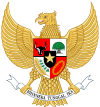| United States of Indonesia Cabinet Kabinet Republik Indonesia Serikat | |
|---|---|
10th-11th Cabinet of Indonesia | |
| 1949–1950 | |
 | |
| Date formed | 20 December 1949 (1949-12-20) |
| Date dissolved | 6 September 1950 (1950-09-06) |
| People and organisations | |
| Head of state | Sukarno |
| Head of government | Mohammad Hatta |
| No. of ministers | 16 ministers |
| History | |
| Predecessor | Hatta II Cabinet |
| Successor | Natsir Cabinet |
| ||
|---|---|---|
|
Pre-independence Domestic policy
Foreign policy Speeches Family Media and legacy
|
||
The Republic of the United States of Indonesia Cabinet (Indonesian: Kabinet Republik Indonesia Serikat) was established as a result of the formation of the United States of Indonesia following the transfer of sovereignty from the Dutch colonial power. It lasted less than a year before Indonesia became a unitary state.
Background
President Sukarno, the president of the United States of Indonesia, appointed Mohammad Hatta, Ida Anak Agung Gde Agung, Sri Sultan Hamengku Buwono IX and Sultan Hamid II to choose the cabinet of the new country. Two days later, on 20 December 1949, the cabinet was sworn in, and a week later formally accepted the sovereignty of the nation from the Dutch.
Composition
Only five cabinet members came from the outside the federal state of the Republic of Indonesia. Hatta worked hard to ensure that ministers were appointed based on competence, rather than party affiliation, and four of the ministers from the Republic of Indonesia did not belong to any party. In practice, Hatta had a very dominant position in the cabinet, due to his close relationship with Sukarno, his success at the Dutch–Indonesian Round Table Conference and his role during key events during the War of Independence.
| Portfolio | Holder | Party | Origin |
|---|---|---|---|
| Prime Minister | |||
| Prime Minister | Mohammad Hatta | Non-party | Republic of Indonesia |
| Departmental Ministers | |||
| Home Affairs | Ida Anak Agung Gde Agung | Non-party | East Indonesia |
| Foreign Affairs | Mohammad Hatta | Non-party | Republic of Indonesia |
| Defense | Sri Sultan Hamengkubuwana IX | Non-party | Republic of Indonesia |
| Justice | Soepomo | Non-party | Republic of Indonesia |
| Finance | Sjafruddin Prawiranegara | Masyumi | Republic of Indonesia |
| Education and Culture | Abu Hanifah | Masyumi | Republic of Indonesia |
| Health | Johannes Leimena | Parkindo | Republic of Indonesia |
| Social Affairs | Moh. Kosasih Purwanegara | Non-party | Pasundan |
| Information | Arnold Mononutu | Indonesian National Party (PNI) | East indonesia |
| Transportation, Power, and Public Works | Herling Laoh | PNI | Republic of Indonesia |
| Welfare | Djuanda | Non-party | Republic of Indonesia |
| Labor | Wilopo | PNI | Republic of Indonesia |
| Religious Affairs | Wahid Hasyim | Masyumi | Republic of Indonesia |
| State Ministers | |||
| State Minister | Sultan Hamid II | Non-party | West Kalimantan |
| State Minister | Mohamad Roem | Masyumi | Republic of Indonesia |
| State Minister | Soeparno Honggopati Tjitrohoepojo | Non-party | Madoera |
Changes
On 19 January 1950, State Minister Moh. Roem was appointed to the RUSI High Commission in The Hague and resigned from the cabinet. Following a report from the attorney general, State Minister Sultan Hamid II was dismissed on 5 April 1950 for involvement in the rebellion led by Raymond Westerling. Neither of these state ministers were replaced.
The end of the cabinet
On 15 August 1950, the United States of Indonesia ceased to exist and was replaced by the unitary state of Indonesia. On the same day, Prime Minister Hatta returned his mandate to President Sukarno. The Republic of the United States of Indonesia Cabinet was officially dissolved but continued as the cabinet of the Republic of Indonesia until a new cabinet could be formed.
References
- Feith, Herbert (2007) The Decline of Constitutional Democracy in Indonesia Equinox Publishing (Asia) Pte Ltd, ISBN 978-979-3780-45-0
- Kahin, George McTurnan (1952) Nationalism and Revolution in Indonesia Cornell University Press, ISBN 0-8014-9108-8
- Ricklefs (1982), A History of Modern Indonesia, Macmillan Southeast Asian reprint, ISBN 0-333-24380-3
- Simanjuntak, P. N. H. (2003), Kabinet-Kabinet Republik Indonesia: Dari Awal Kemerdekaan Sampai Reformasi (in Indonesian), Jakarta: Djambatan, pp. 91–102, ISBN 979-428-499-8.
Notes
- Feith (2007) p46
- Feith (2007) pp 47-52
- Simanjuntak (2003) p94
- Feith (2007) p47
- Simanjuntak (2003) p102
| National Revolution (Presidential) |  | |
|---|---|---|
| National Revolution (Parliamentary) | ||
| United States of Indonesia |
| |
| Liberal Democracy | ||
| Guided Democracy | ||
| New Order | ||
| Reform Era | ||

